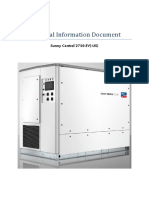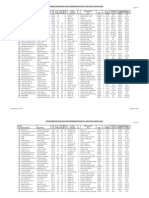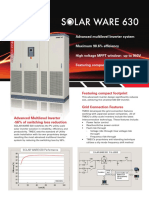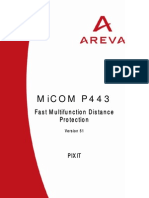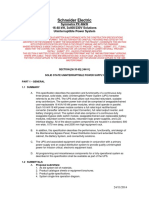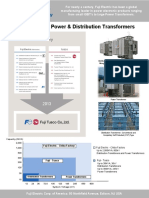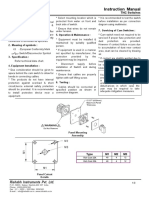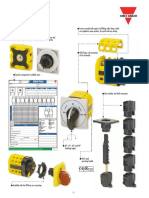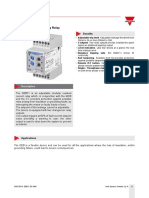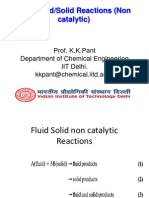Requirements For Medium-Voltage Transformers and Transformers For Internal Power Supply For Sunny Central and Sunny Central Storage
Requirements For Medium-Voltage Transformers and Transformers For Internal Power Supply For Sunny Central and Sunny Central Storage
Uploaded by
ShiaTVfanCopyright:
Available Formats
Requirements For Medium-Voltage Transformers and Transformers For Internal Power Supply For Sunny Central and Sunny Central Storage
Requirements For Medium-Voltage Transformers and Transformers For Internal Power Supply For Sunny Central and Sunny Central Storage
Uploaded by
ShiaTVfanOriginal Title
Copyright
Available Formats
Share this document
Did you find this document useful?
Is this content inappropriate?
Copyright:
Available Formats
Requirements For Medium-Voltage Transformers and Transformers For Internal Power Supply For Sunny Central and Sunny Central Storage
Requirements For Medium-Voltage Transformers and Transformers For Internal Power Supply For Sunny Central and Sunny Central Storage
Uploaded by
ShiaTVfanCopyright:
Available Formats
Technical Information
Requirements for medium-voltage transformers
and transformers for internal power supply for
SUNNY CENTRAL and SUNNY CENTRAL
STORAGE
ENGLISH SC_Trafo-TI-en-71 | Version 7.1
Table of Contents SMA Solar Technology AG
Table of Contents
1 Information on this Document..................................................................................................... 3
1.1 Validity ............................................................................................................................................................. 3
1.2 Limited statutory warranty ............................................................................................................................... 3
2 Technical requirements for the MV transformer........................................................................ 4
2.1 General Requirements..................................................................................................................................... 4
2.2 Requirements for two-winding transformers used to connect one inverter ................................................... 5
2.3 Requirements for four-winding transformers used to connect two inverters ................................................. 6
2.4 Requirements for multi-winding transformers used to connect three inverters.............................................. 8
2.5 Requirements for multi-winding transformers used to connect four inverters................................................ 8
3 Technical requirements for the transformer for internal power supply .................................. 9
3.1 General Requirements..................................................................................................................................... 9
3.2 Requirements for the connection to the park-side utility grid ........................................................................ 9
3.3 Requirements for the connection to the AC output of the inverter ................................................................ 10
4 Appendix ...................................................................................................................................... 11
4.1 Technical data of the inverter ......................................................................................................................... 11
4.2 Technical Data of the Transformers ................................................................................................................ 15
2 SC_Trafo-TI-en-71 Technical Information
SMA Solar Technology AG 1 Information on this Document
1 Information on this Document
1.1 Validity
This document applied to all device types of the Sunny Central inverter.
It describes the requirements for MV transformers and transformers for internal power supply that are connected to
Sunny Central inverters and provided by the customer.
Please note that not all Sunny Central inverters can be combined with all MV transformers. For more details, please
refer to the following pages.
1.2 Limited statutory warranty
SMA Solar Technology AG only provides statutory warranty for products purchased from SMA Solar Technology AG.
SMA Solar Technology AG America LLC only provides statutory warranty for products purchased from
SMA Solar Technology AG America LLC.
The statutory warranty for the inverters and other products purchased from SMA does not apply if the requirements
described in this document are not met.
Technical Information SC_Trafo-TI-en-71 3
2 Technical requirements for the MV transformer SMA Solar Technology AG
2 Technical requirements for the MV transformer
2.1 General Requirements
☐ The MV transformer can be of the liquid-immersed transformer type (for example, with mineral oil or organic oil)
or of the dry-type transformer.
☐ The MV transformer must be designed at its low-voltage windings for voltages that arise during pulsed mode of
the inverter.
☐ The power connection used must have suitable insulation resistance since voltages to ground of ±2400 V at the
most occur when the inverter is in pulsed mode (see Section 4.1 "Technical data of the inverter", page 11).
Figure 1: AC voltage level for SC 2500-EV
☐ The low‑voltage windings of the MV transformer must be designed for voltages that are capable of a rate of rise
in voltage dV/dt of up to 500 V/µs to ground. The line-to-line voltages are sinusoidal.
☐ It is recommended to provide a shield winding grounded on the tank between the low‑voltage windings and the
high‑voltage windings. This serves as an additional dV/dt filter.
☐ Each inverter requires a separate, galvanically insulated low-voltage winding. Therefore, the parallel operation of
several inverters on one low-voltage winding is not permissible.
☐ The voltages at the low-voltage windings of the MV transformer must match the AC output voltage of the inverter
(see Section 4.1 "Technical data of the inverter", page 11).
☐ The voltage level on the high-voltage side of the MV transformer must be selected according to the grid-
connection point. The MV transformer must be connected to the medium-voltage grid or the high-voltage grid.
Connection to the low-voltage grid is not permissible.
☐ When connecting to the medium-voltage grid, the use of a MV transformer with tap changer on the high voltage
side is recommended. MV transformer with tap changer on the high-voltage side enables an adaptation to the
voltage level of the medium-voltage grid.
☐ The MV transformer must be rated according to the temperature-dependent power behavior of the inverter.
☐ For thermal design, the load curve of the MV transformer and the ambient conditions at the respective mounting
location must be taken into account. When operating with an additional reactive power supply, the increased
loads in the design of the MV transformer are to be observed (for information about the reactive power supply of
the inverter, see the inverter documentation).
☐ When designing the MV transformer for use with the Sunny Central Storage, it is important to remember that due
to battery operation the MV transformer hardly cools down at all at night.
4 SC_Trafo-TI-en-71 Technical Information
SMA Solar Technology AG 2 Technical requirements for the MV transformer
☐ The MV transformer must be designed for the AC output currents of the inverter (see Section 4.1 "Technical data
of the inverter", page 11).
☐ If grounding of the MV transformer on the medium voltage side is required, the type of grounding regarding the
entire system including the MV transformer must be taken into consideration.
☐ The consequences of any error, such as a short circuit, ground fault or voltage failure, must be taken into account
when considering the overall system.
☐ The country-specific power frequency must be taken into account.
☐ The applicable country-specific standards and directives must be taken into account.
☐ SMA reserves the right to measure the currents of the sine-wave filter capacitors during commissioning and, if
necessary, to optimize the entire system.
2.2 Requirements for two-winding transformers used to connect
one inverter
☐ The following vector groups are recommended for handling the corresponding neutral points.
Insulated neutral point on Resonant grounding on medium- Low-resistance grounded
medium-voltage side voltage side neutral point
Dy11, Dy5, Dy1, Dd0, Dd6 YNy0 YNy0
Yd11, Yd5, Yd1 YNd11, YNd5, YNd1
☐ If there is a neutral-point terminal on the low-voltage side, this neutral-point terminal must not be grounded or
connected.
Figure 2: Circuit diagram of two-winding transformers (example)
Technical Information SC_Trafo-TI-en-71 5
2 Technical requirements for the MV transformer SMA Solar Technology AG
☐ The relative impedance voltage Vk of the MV transformer between grid-connection point and AC output of the
inverter must be between the minimum value Vk min and the maximum value Vk max. The relative impedance voltage
is based the nominal power of the MV transformer (see Section 4.2 "Technical Data of the Transformers",
page 15).
2.3 Requirements for four-winding transformers used to connect
two inverters
A four-winding transformer (double story transformer) consists of two high-voltage windings and two low-voltage
windings.
☐ It is recommended for four-winding transformers to provide a separate shield winding that is grounded at the tank,
between each low-voltage winding and high-voltage winding.
A B C
D
G
E F
Figure 3: Four-winding transformers with separate shield windings
Position Designation
A Core
B Low-voltage winding 1
C High-voltage winding 1
D Shield winding 1
E Low-voltage winding 2
6 SC_Trafo-TI-en-71 Technical Information
SMA Solar Technology AG 2 Technical requirements for the MV transformer
Position Designation
F High-voltage winding 2
G Shield winding 2
☐ Four-winding transformers with varying vector groups can be used. The following vector groups are recommended
for handling the corresponding neutral points.
Insulated neutral point on Resonant grounding on medium- Low-resistance grounded
medium-voltage side voltage side neutral point
Dy11y11, Dy5y5, Dy1y1, Dd0d0, YNy0y0 YNy0y0
Dd6d6 YNd11d11, YNd5d5, YNd1d1
Yd11d11, Yd5d5, Yd1d1
• If there is a neutral-point terminal on the low-voltage side, this neutral-point terminal must not be grounded or
connected.
Figure 4: Circuit diagram of four-winding transformers (example)
☐ Four-winding transformers must be designed for an asymmetrical load flow in the low-voltage systems. This means
that for long-term operation, the transformer must be designed for the feed-in of one inverter only.
☐ Four-winding transformers must be designed for the use of inverters of the Sunny Central Storage series so that full
power can be fed in at one of the low-voltage windings and that full power can be used at the other low-voltage
winding. The transformer must be designed for continuous operation in this operating state.
☐ The relative impedance voltage Vk of the MV transformer between grid-connection point and AC output of the
inverter must be between the minimum value Vk min and the maximum value Vk max. The relative impedance voltage
is based on half the nominal power of the MV transformer (see Section 4.2 "Technical Data of the Transformers",
page 15).
☐ The difference of the relative impedance voltages between the grid-connection point of the AC outputs of the two
inverters must not exceed 0.5% (see Section 4.2 "Technical Data of the Transformers", page 15).
Technical Information SC_Trafo-TI-en-71 7
2 Technical requirements for the MV transformer SMA Solar Technology AG
Example: Permissible Difference of Impedance Voltages Vk dif max
The value of the relative impedance voltage from the high-voltage winding to low-voltage winding 1 is 6.0%. The
value of the relative impedance voltage from the high-voltage winding to low-voltage winding 2 is 5.6%. The
deviation of the relative impedance voltages is permissible since the difference amounts to 0.4% and is thus smaller
than 0.5%.
Example: Non-Permissible Difference of Impedance Voltages Vk dif max
The value of the relative impedance voltage from the high-voltage winding to low-voltage winding 1 is 6.0%. The
value of the relative impedance voltage from the high-voltage winding to low-voltage winding 2 is 5.4%. The
deviation of the relative impedance voltages is not permissible since the difference amounts to 0.6% and is thus
greater than 0.5%.
☐ The value of the relative impedance voltage Vk 1-2 between the two low-voltage winding must be at least 9%. The
impedance voltage is based on half the nominal power of the MV transformer. This value can be determined by
shorting a low-voltage winding and increasing the voltage on the other low-voltage winding until the nominal
current of a low-voltage system flows. During this time, the high-voltage windings are in no-load operation.
Figure 5: Circuit diagram for determining the impedance voltage Uk 1-2 in four-winding transformers (example)
2.4 Requirements for multi-winding transformers used to connect three
inverters
The requirements for MV transformers to which three inverters are to be connected are the same as for two-winding
transformers. Three two-winding active parts are mounted in a tank. All three active parts must be set up with separated
cores.
2.5 Requirements for multi-winding transformers used to connect four
inverters
The requirements for MV transformers to which four inverters are to be connected are the same as for four-winding
transformers. Two four-winding active parts of double story design are mounted in a tank. Both active parts must be set
up with separated cores.
8 SC_Trafo-TI-en-71 Technical Information
SMA Solar Technology AG 3 Technical requirements for the transformer for internal power supply
3 Technical requirements for the transformer for internal power supply
3.1 General Requirements
The inverters are equipped by default with an internal transformer for internal power supply. However, the inverters
can also be supplied externally.
General Requirements
☐ The transformer for internal power supply must be of three-phase design.
☐ The secondary side of the transformer for internal power supply must supply a voltage of 230 V/400 V (3/N/PE)
to connect to the inverter.
☐ The transformer for internal power supply must be designed for an asymmetric load of 80%.
☐ A transformer for internal power supply with the Dyn5 or Dyn11 vector group is recommended.
☐ A shield winding that has to be grounded at the enclosure must be provided between the windings of the
transformer for internal power supply.
☐ The transformer for internal power supply must be equipped with an external protection against overload.
☐ The ambient conditions of the transformer for internal power supply must be taken into account.
☐ The country-specific power frequencies must be taken into account.
☐ The applicable country-specific standards and directives must be taken into account.
☐ The transformer for internal power supply must provide a power of at least 8.4 kVA per inverter.
☐ Several inverters can be supplied by one transformer for internal power supply if this transformer can provide a
power of at least 8.4 kV per inverter.
☐ The transformer for internal power supply must have external short-circuit protection ensuring that any potential
short-circuit currents are limited to 10.0 kA at the inverter.
3.2 Requirements for the connection to the park-side utility grid
Figure 6: Connection of the transformer for internal power supply to the park-side utility grid
Technical Information SC_Trafo-TI-en-71 9
3 Technical requirements for the transformer for internal power supply SMA Solar Technology AG
☐ For the connection to the park-side utility grid, the primary voltage of the transformer for internal power supply
must be equal to the grid voltage.
3.3 Requirements for the connection to the AC output of the inverter
Figure 7: Connection of the transformer for internal power supply to the inverter's AC output
☐ The primary voltages of the transformer for internal power supply must correspond to the AC output voltages of
the inverter (see Section 4.1 "Technical data of the inverter", page 11).
☐ On the primary side, the transformer for internal power supply must be suitable for the pulsed mode of an inverter.
☐ On the primary side, the transformer for internal power supply must be suitable for voltages that arise from pulsed
mode of the inverter.
☐ The power connection used must have suitable insulation resistance since voltages to ground of ±2,400 V at the
most occur when the inverter is in pulsed mode (see Section 4.1 "Technical data of the inverter", page 11).
☐ On the primary side, the transformer for internal power supply must be designed for voltages reaching a rate of
rise in voltage dV/dt of up to 500 V/µs to ground. The line-to-line voltages are sinusoidal.
☐ The windings of the transformer for internal power supply must be galvanically insulated. Do not use
autotransformers.
10 SC_Trafo-TI-en-71 Technical Information
SMA Solar Technology AG 4 Appendix
4 Appendix
4.1 Technical data of the inverter
Sunny Central
Inverter type DC voltage AC voltage AC peak volt- AC current
age to
ground at 35°C at 50°C
SC 2200 1100 V 385 V ±1800 V 3300 A 3000 A
SC 2475 1100 V 434 V ±1800 V 3292 A 2993 A
SC 2500-EV 1500 V 550 V ±2400 V 2624 A 2362 A
SC 2750-EV 1500 V 600 V ±2400 V 2646 A 2406 A
SC 3000-EV 1500 V 655 V ±2400 V 2646 A 2380 A
Sunny Central UP
Inverter type DC voltage AC voltage AC peak volt- AC current
age to
ground at 35°C at 50°C
SC 2660 UP 1500 V 600 V ±2400 V 2566 A 2309 A
SC 2800 UP 1500 V 630 V ±2400 V 2566 A 2309 A
SC 2930 UP 1500 V 660 V ±2400 V 2566 A 2309 A
SC 3060 UP 1500 V 690 V ±2400 V 2566 A 2309 A
SC 4000 UP 1500 V 600 V ±2400 V 3850 A 3465 A
SC 4200 UP 1500 V 630 V ±2400 V 3850 A 3465 A
SC 4400 UP 1500 V 660 V ±2400 V 3850 A 3465 A
SC 4600 UP 1500 V 690 V ±2400 V 3850 A 3465 A
Sunny Central US
Inverter type DC voltage AC voltage AC peak volt- AC current
age to
ground at 35°C at 50°C
SC 1760-US 1000 V 385 V ±1800 V 2640 A 2640 A
SC 1850-US 1000 V 385 V ±1800 V 2774 A 2774 A
SC 2000-US 1000 V 385 V ±1800 V 3300 A (ap- 3000 A
parent current)
3000 A (active
current)
Technical Information SC_Trafo-TI-en-71 11
4 Appendix SMA Solar Technology AG
Inverter type DC voltage AC voltage AC peak volt- AC current
age to
ground at 35°C at 50°C
SC 2000-EV-US 1500 V 550 V ±2400 V 2310 A (ap- 2310 A (ap-
parent current) parent current)
2100 A (active 2100 A (active
current) current)
SC 2200-US 1000 V 385 V ±1800 V 3300 A 3000 A
SC 2500-EV-US 1500 V 550 V ±2400 V 2624 A 2362 A
SC 2750-EV-US 1500 V 600 V ±2400 V 2646 A 2406 A
Sunny Central UP-US
Inverter type DC voltage AC voltage AC peak volt- AC current
age to
ground at 35°C at 50°C
SC 2660 UP-US 1500 V 600 V ±2400 V 2566 A 2309 A
SC 2750 UP-US 1500 V 630 V ±2400 V 2520 A 2270 A
SC 2800 UP-US 1500 V 630 V ±2400 V 2566 A 2309 A
SC 2930 UP-US 1500 V 660 V ±2400 V 2566 A 2309 A
SC 3060 UP-US 1500 V 690 V ±2400 V 2566 A 2309 A
SC 4000 UP-US 1500 V 600 V ±2400 V 3850 A 3465 A
SC 4200 UP-US 1500 V 630 V ±2400 V 3850 A 3465 A
SC 4400 UP-US 1500 V 660 V ±2400 V 3850 A 3465 A
SC 4600 UP-US 1500 V 690 V ±2400 V 3850 A 3465 A
Sunny Central Storage
Inverter type DC voltage AC voltage AC peak volt- AC current
age to
ground at 25°C at 50°C
SCS 1900 1100 V 337 V ±1800 V 3260 A 2960 A
SCS 2200 1100 V 385 V ±1800 V 3300 A 3000 A
SCS 2475 1100 V 434 V ±1800 V 3292 A 2993 A
SCS 2500-EV 1500 V 550 V ±2400 V 2624 A 2362 A
SCS 2750-EV 1500 V 600 V ±2400 V 2646 A 2406 A
SCS 2900 1100 V 520 V ±1800 V 3265 A 2968 A
SCS 3000-EV 1500 V 655 V ±2400 V 2646 A 2380 A
12 SC_Trafo-TI-en-71 Technical Information
SMA Solar Technology AG 4 Appendix
Sunny Central Storage UP
Inverter type DC voltage AC voltage AC peak volt- AC current
age to
ground at 25°C at 50°C
SCS 2750 UP 1500 V 600 V ±2400 V 2646 A 2406 A
SCS 3450 UP 1500 V 600 V ±2400 V 3320 A 2822 A
SCS 3600 UP 1500 V 630 V ±2400 V 3320 A 2822 A
SCS 3800 UP 1500 V 660 V ±2400 V 3320 A 2822 A
SCS 3950 UP 1500 V 690 V ±2400 V 3320 A 2822 A
Sunny Central Storage UP-XT
Inverter type DC voltage AC voltage AC peak volt- AC current
age to
ground at 25°C at 50°C
SCS 2300 UP-XT 1500 V 600 V ±2400 V 2566 A 2181 A
SCS 2400 UP-XT 1500 V 630 V ±2400 V 2566 A 2181 A
SCS 2530 UP-XT 1500 V 660 V ±2400 V 2566 A 2181 A
SCS 2630 UP-XT 1500 V 690 V ±2400 V 2566 A 2181 A
SCS 3450 UP-XT 1500 V 600 V ±2400 V 3850 A 3272 A
SCS 3600 UP-XT 1500 V 630 V ±2400 V 3850 A 3272 A
SCS 3800 UP-XT 1500 V 660 V ±2400 V 3850 A 3272 A
SCS 3950 UP-XT 1500 V 690 V ±2400 V 3850 A 3272 A
Sunny Central Storage US
Inverter type DC voltage AC voltage AC peak volt- AC current
age to
ground at 25°C at 50°C
SCS 2200-US 1000 V 385 V ±1800 V 3300 A 3000 A
SCS 2475-US 1000 V 434 V ±1800 V 3292 A 2993 A
SCS 2500-EV-US 1500 V 550 V ±2400 V 2624 A 2362 A
SCS 2750-EV-US 1500 V 600 V ±2400 V 2646 A 2406 A
SCS 2900-US 1000 V 520 V ±1800 V 3265 A 2968 A
Sunny Central Storage UP-US
Inverter type DC voltage AC voltage AC peak volt- AC current
age to
ground at 25°C at 50°C
SCS 2750 UP-US 1500 V 600 V ±2400 V 2646 A 2646 A
Technical Information SC_Trafo-TI-en-71 13
4 Appendix SMA Solar Technology AG
Inverter type DC voltage AC voltage AC peak volt- AC current
age to
ground at 25°C at 50°C
SCS 3450 UP-US 1500 V 600 V ±2400 V 3320 A 2822 A
SCS 3600 UP-US 1500 V 630 V ±2400 V 3320 A 2822 A
SCS 3800 UP-US 1500 V 660 V ±2400 V 3320 A 2822 A
SCS 3950 UP-US 1500 V 690 V ±2400 V 3320 A 2822 A
Sunny Central Storage UP-XT-US
Inverter type DC voltage AC voltage AC peak AC current
voltage to
ground at 25°C at 50°C
SCS 2300 UP-XT-US 1500 V 600 V ±2400 V 2566 A 2181 A
SCS 2400 UP-XT-US 1500 V 630 V ±2400 V 2566 A 2181 A
SCS 2530 UP-XT-US 1500 V 660 V ±2400 V 2566 A 2181 A
SCS 2630 UP-XT-US 1500 V 690 V ±2400 V 2566 A 2181 A
SCS 3450 UP-XT-US 1500 V 600 V ±2400 V 3850 A 3272 A
SCS 3600 UP-XT-US 1500 V 630 V ±2400 V 3850 A 3272 A
SCS 3800 UP-XT-US 1500 V 660 V ±2400 V 3850 A 3272 A
SCS 3950 UP-XT-US 1500 V 690 V ±2400 V 3850 A 3272 A
14 SC_Trafo-TI-en-71 Technical Information
SMA Solar Technology AG 4 Appendix
4.2 Technical Data of the Transformers
Sunny Central
Type of the Two-winding transformers Four-winding transformers
Inverter
Vk min Vk nom Vk max Vk min Vk nom Vk max Vk dif max Vk 1-2 min
SC 2200 5.0 % 6.0 % 8.5 % 5.0 % 6.0 % 8.5 % 0.5 % 9.0 %
SC 2475 5.0 % 6.0 % 8.5 % 5.0 % 6.0 % 8.5 % 0.5 % 9.0 %
SC 2500-EV 5.0 % 6.0 % 8.5 % 5.0 % 6.0 % 8.5 % 0.5 % 9.0 %
SC 2750-EV 5.0 % 6.0 % 8.5 % 5.0 % 6.0 % 8.5 % 0.5 % 9.0 %
SC 3000-EV 5.0 % 6.0 % 8.5 % 5.0 % 6.0 % 8.5 % 0.5 % 9.0 %
Sunny Central UP
Type of the Two-winding transformers Four-winding transformers
Inverter
Vk min Vk nom Vk max Vk min Vk nom Vk max Vk dif max Vk 1-2 min
SC 2660 UP 6.0 % - 8.5 % 6.0 % - 8.5 % 0.5 % 9.0 %
SC 2800 UP 6.0 % - 8.5 % 6.0 % - 8.5 % 0.5 % 9.0 %
SC 2930 UP 6.0 % - 8.5 % 6.0 % - 8.5 % 0.5 % 9.0 %
SC 3060 UP 6.0 % - 8.5 % 6.0 % - 8.5 % 0.5 % 9.0 %
SC 4000 UP 6.0 % - 8.5 % 6.0 % - 8.5 % 0.5 % 9.0 %
SC 4200 UP 6.0 % - 8.5 % 6.0 % - 8.5 % 0.5 % 9.0 %
SC 4400 UP 6.0 % - 8.5 % 6.0 % - 8.5 % 0.5 % 9.0 %
SC 4600 UP 6.0 % - 8.5 % 6.0 % - 8.5 % 0.5 % 9.0 %
Sunny Central US
Type of the Two-winding transformers Four-winding transformers
Inverter
Vk min Vk nom Vk max Vk min Vk nom Vk max Vk dif max Vk 1-2 min
SC 1760-US 5.0 % 6.0 % 8.5 % 5.0 % 6.0 % 8.5 % 0.5 % 9.0 %
SC 1850-US 5.0 % 6.0 % 8.5 % 5.0 % 6.0 % 8.5 % 0.5 % 9.0 %
SC 2000-US 5.0 % 6.0 % 8.5 % 5.0 % 6.0 % 8.5 % 0.5 % 9.0 %
SC 2000-EV-US 5.0 % 6.0 % 8.5 % 5.0 % 6.0 % 8.5 % 0.5 % 9.0 %
SC 2200-US 5.0 % 6.0 % 8.5 % 5.0 % 6.0 % 8.5 % 0.5 % 9.0 %
SC 2500-EV-US 5.0 % 6.0 % 8.5 % 5.0 % 6.0 % 8.5 % 0.5 % 9.0 %
SC 2750-EV-US 5.0 % 6.0 % 8.5 % 5.0 % 6.0 % 8.5 % 0.5 % 9.0 %
Technical Information SC_Trafo-TI-en-71 15
4 Appendix SMA Solar Technology AG
Sunny Central UP-US
Type of the Two-winding transformers Four-winding transformers
Inverter
Vk min Vk nom Vk max Vk min Vk nom Vk max Vk dif max Vk 1-2 min
SC 2660 UP-US 6.0 % - 8.5 % 6.0 % - 8.5 % 0.5 % 9.0 %
SC 2750 UP-US 6.0 % - 8.5 % 6.0 % - 8.5 % 0.5 % 9.0 %
SC 2800 UP-US 6.0 % - 8.5 % 6.0 % - 8.5 % 0.5 % 9.0 %
SC 2930 UP-US 6.0 % - 8.5 % 6.0 % - 8.5 % 0.5 % 9.0 %
SC 3060 UP-US 6.0 % - 8.5 % 6.0 % - 8.5 % 0.5 % 9.0 %
SC 4000 UP-US 6.0 % - 8.5 % 6.0 % - 8.5 % 0.5 % 9.0 %
SC 4200 UP-US 6.0 % - 8.5 % 6.0 % - 8.5 % 0.5 % 9.0 %
SC 4400 UP-US 6.0 % - 8.5 % 6.0 % - 8.5 % 0.5 % 9.0 %
SC 4600 UP-US 6.0 % - 8.5 % 6.0 % - 8.5 % 0.5 % 9.0 %
Sunny Central Storage
Type of the Two-winding transformers Four-winding transformers
Inverter
Vk min Vk nom Vk max Vk min Vk nom Vk max Vk dif max Vk 1-2 min
SCS 1900 5.0 % 6.0 % 8.5 % 5.0 % 6.0 % 8.5 % 0.5 % 9.0 %
SCS 2200 5.0 % 6.0 % 8.5 % 5.0 % 6.0 % 8.5 % 0.5 % 9.0 %
SCS 2475 5.0 % 6.0 % 8.5 % 5.0 % 6.0 % 8.5 % 0.5 % 9.0 %
SCS 2500-EV 5.0 % 6.0 % 8.5 % 5.0 % 6.0 % 8.5 % 0.5 % 9.0 %
SCS 2750-EV 5.0 % 6.0 % 8.5 % 5.0 % 6.0 % 8.5 % 0.5 % 9.0 %
SCS 2900 5.0 % 6.0 % 8.5 % 5.0 % 6.0 % 8.5 % 0.5 % 9.0 %
SCS 3000-EV 5.0 % 6.0 % 8.5 % 5.0 % 6.0 % 8.5 % 0.5 % 9.0 %
Sunny Central Storage UP
Type of the Two-winding transformers Four-winding transformers
Inverter
Vk min Vk nom Vk max Vk min Vk nom Vk max Vk dif max Vk 1-2 min
SCS 2750 UP 6.0 % - 8.5 % 6.0 % - 8.5 % 0.5 % 9.0 %
SCS 3450 UP 6.0 % - 8.5 % 6.0 % - 8.5 % 0.5 % 9.0 %
SCS 3600 UP 6.0 % - 8.5 % 6.0 % - 8.5 % 0.5 % 9.0 %
SCS 3800 UP 6.0 % - 8.5 % 6.0 % - 8.5 % 0.5 % 9.0 %
SCS 3950 UP 6.0 % - 8.5 % 6.0 % - 8.5 % 0.5 % 9.0 %
16 SC_Trafo-TI-en-71 Technical Information
SMA Solar Technology AG 4 Appendix
Sunny Central Storage UP-XT
Type of the Two-winding transformers Four-winding transformers
Inverter
Vk min Vk nom Vk max Vk min Vk nom Vk max Vk dif max Vk 1-2 min
SCS 2300 UP-XT 6.0 % - 8.5 % 6.0 % - 8.5 % 0.5 % 9.0 %
SCS 2400 UP-XT 6.0 % - 8.5 % 6.0 % - 8.5 % 0.5 % 9.0 %
SCS 2530 UP-XT 6.0 % - 8.5 % 6.0 % - 8.5 % 0.5 % 9.0 %
SCS 2630 UP-XT 6.0 % - 8.5 % 6.0 % - 8.5 % 0.5 % 9.0 %
SCS 3450 UP-XT 6.0 % - 8.5 % 6.0 % - 8.5 % 0.5 % 9.0 %
SCS 3600 UP-XT 6.0 % - 8.5 % 6.0 % - 8.5 % 0.5 % 9.0 %
SCS 3800 UP-XT 6.0 % - 8.5 % 6.0 % - 8.5 % 0.5 % 9.0 %
SCS 3950 UP-XT 6.0 % - 8.5 % 6.0 % - 8.5 % 0.5 % 9.0 %
Sunny Central Storage US
Type of the Two-winding transformers Four-winding transformers
Inverter
Vk min Vk nom Vk max Vk min Vk nom Vk max Vk dif max Vk 1-2 min
SCS 2200-US 5.0 % 6.0 % 8.5 % 5.0 % 6.0 % 8.5 % 0.5 % 9.0 %
SCS 2475-US 5.0 % 6.0 % 8.5 % 5.0 % 6.0 % 8.5 % 0.5 % 9.0 %
SCS 2500-EV-US 5.0 % 6.0 % 8.5 % 5.0 % 6.0 % 8.5 % 0.5 % 9.0 %
SCS 2750-EV-US 5.0 % 6.0 % 8.5 % 5.0 % 6.0 % 8.5 % 0.5 % 9.0 %
SCS 2900-US 5.0 % 6.0 % 8.5 % 5.0 % 6.0 % 8.5 % 0.5 % 9.0 %
Sunny Central Storage UP-US
Type of the Two-winding transformers Four-winding transformers
Inverter
Vk min Vk nom Vk max Vk min Vk nom Vk max Vk dif max Vk 1-2 min
SCS 2750 UP-US 6.0 % - 8.5 % 6.0 % - 8.5 % 0.5 % 9.0 %
SCS 3450 UP-US 6.0 % - 8.5 % 6.0 % - 8.5 % 0.5 % 9.0 %
SCS 3600 UP-US 6.0 % - 8.5 % 6.0 % - 8.5 % 0.5 % 9.0 %
SCS 3800 UP-US 6.0 % - 8.5 % 6.0 % - 8.5 % 0.5 % 9.0 %
SCS 3950 UP-US 6.0 % - 8.5 % 6.0 % - 8.5 % 0.5 % 9.0 %
Sunny Central Storage UP-XT-US
Type of the Two-winding transformers Four-winding transformers
Inverter
Vk min Vk nom Vk max Vk min Vk nom Vk max Vk dif max Vk 1-2 min
SCS 2300 UP-XT-US 6.0 % - 8.5 % 6.0 % - 8.5 % 0.5 % 9.0 %
Technical Information SC_Trafo-TI-en-71 17
4 Appendix SMA Solar Technology AG
Type of the Two-winding transformers Four-winding transformers
Inverter
Vk min Vk nom Vk max Vk min Vk nom Vk max Vk dif max Vk 1-2 min
SCS 2400 UP-XT-US 6.0 % - 8.5 % 6.0 % - 8.5 % 0.5 % 9.0 %
SCS 2530 UP-XT-US 6.0 % - 8.5 % 6.0 % - 8.5 % 0.5 % 9.0 %
SCS 2630 UP-XT-US 6.0 % - 8.5 % 6.0 % - 8.5 % 0.5 % 9.0 %
SCS 3450 UP-XT-US 6.0 % - 8.5 % 6.0 % - 8.5 % 0.5 % 9.0 %
SCS 3600 UP-XT-US 6.0 % - 8.5 % 6.0 % - 8.5 % 0.5 % 9.0 %
SCS 3800 UP-XT-US 6.0 % - 8.5 % 6.0 % - 8.5 % 0.5 % 9.0 %
SCS 3950 UP-XT-US 6.0 % - 8.5 % 6.0 % - 8.5 % 0.5 % 9.0 %
18 SC_Trafo-TI-en-71 Technical Information
www.SMA-Solar.com
You might also like
- MX GC Error CodesDocument1,236 pagesMX GC Error CodesRyan86% (35)
- Full Revised Specification For Well Head Control PanelDocument105 pagesFull Revised Specification For Well Head Control Panelamjath584100% (12)
- VM Ii 3.2kva 3.5kva 5kva 5.5kvaDocument34 pagesVM Ii 3.2kva 3.5kva 5kva 5.5kvaJerry TruonoNo ratings yet
- Bonfiglioli RPS InverterDocument16 pagesBonfiglioli RPS Inverterwesley maxmiliano0% (1)
- Manual-tp-mcenpc23-Rev 2.5 (June 19, 2020)Document80 pagesManual-tp-mcenpc23-Rev 2.5 (June 19, 2020)Ron100% (1)
- BOS Remington Solar Facilty Staff Report FINALDocument19 pagesBOS Remington Solar Facilty Staff Report FINALFauquier Now0% (1)
- Apt Aerox III 3.2kw - Manual 20181224Document41 pagesApt Aerox III 3.2kw - Manual 20181224atif jabbarNo ratings yet
- Susol RMU - E - 180702Document28 pagesSusol RMU - E - 180702Sandeep Kr Arya0% (1)
- RP100-RX Owners ManualDocument6 pagesRP100-RX Owners Manualcynneath4045No ratings yet
- Flusarc-36 Op Main (En)Document32 pagesFlusarc-36 Op Main (En)George AsuncionNo ratings yet
- Solcon USA HRVS DN MV 10 13pt8kV Spec Guide 2011Document10 pagesSolcon USA HRVS DN MV 10 13pt8kV Spec Guide 2011harmlesdragon100% (1)
- SG125HV V1 UEN Ver14 202002Document106 pagesSG125HV V1 UEN Ver14 202002MaruNo ratings yet
- Advisory Guide: Decentralized Inverter Technology in Large-Scale PV PlantsDocument48 pagesAdvisory Guide: Decentralized Inverter Technology in Large-Scale PV PlantsPablo Omar Luz PedemonteNo ratings yet
- Voltasol InfiniSolar 2KW3KW Manual 48V 20150310Document52 pagesVoltasol InfiniSolar 2KW3KW Manual 48V 20150310SEMONNo ratings yet
- Technical Information SC2750-EVDocument16 pagesTechnical Information SC2750-EVJorgeNo ratings yet
- Solarni Invertori Na Schneider Seriq GTDocument90 pagesSolarni Invertori Na Schneider Seriq GTvessela_knNo ratings yet
- NYISO Interconnection QueueDocument7 pagesNYISO Interconnection QueuepandorasboxofrocksNo ratings yet
- IM201304 ConextCoreXCSeries Installation Manual 990 4613B Rev C PDFDocument82 pagesIM201304 ConextCoreXCSeries Installation Manual 990 4613B Rev C PDFvmramakrishnanNo ratings yet
- SG2-5K User ManualDocument72 pagesSG2-5K User Manualanh nguyenNo ratings yet
- SG60KTL User ManualDocument103 pagesSG60KTL User Manualrbalaji1987No ratings yet
- Auriga UPS - User Manual - DT0475 Rev.003Document45 pagesAuriga UPS - User Manual - DT0475 Rev.003Hong Lan TranNo ratings yet
- Schneider Conext RL Aplicaciones Modbus enDocument49 pagesSchneider Conext RL Aplicaciones Modbus entienchoonNo ratings yet
- TMEIC Manual PDFDocument2 pagesTMEIC Manual PDFKhoi DangNo ratings yet
- Modulys Green PowerDocument34 pagesModulys Green PowerAdenNo ratings yet
- User Manual ACS1000WDocument166 pagesUser Manual ACS1000Whuichuan wang100% (1)
- Operation Manual: Metal-Clad SwitchgearDocument36 pagesOperation Manual: Metal-Clad Switchgearceti7No ratings yet
- Gamesa Electric PV Station 7500 PDFDocument6 pagesGamesa Electric PV Station 7500 PDFCiro LeonNo ratings yet
- External Power Supply For S-Band - 303785P001 Rev BDocument86 pagesExternal Power Supply For S-Band - 303785P001 Rev BivnikonNo ratings yet
- Schneider Conext XW Power System Installation Guide Rev F EngDocument184 pagesSchneider Conext XW Power System Installation Guide Rev F EngniantonsNo ratings yet
- Netsure 701 Ao2 Ao3 Power Supply System User ManualDocument76 pagesNetsure 701 Ao2 Ao3 Power Supply System User ManualToba SamuelNo ratings yet
- Rollarc CompleteDocument30 pagesRollarc Completem khNo ratings yet
- P443 en PX A11Document16 pagesP443 en PX A11Rafael CardosoNo ratings yet
- EM11 User's Manual 2014Document94 pagesEM11 User's Manual 2014nikola gNo ratings yet
- CA132012EN Link PDFDocument2 pagesCA132012EN Link PDFGerardo BáezNo ratings yet
- 2400 Ca001 - en PDocument42 pages2400 Ca001 - en PabenitechNo ratings yet
- Smartpack2 Basic Industrial: User's GuideDocument32 pagesSmartpack2 Basic Industrial: User's GuideraffaeleNo ratings yet
- Voltronic Inverter Setup SOP PDFDocument6 pagesVoltronic Inverter Setup SOP PDFtongaiNo ratings yet
- SF Gas Insulated Ring Main Unit RMUDocument24 pagesSF Gas Insulated Ring Main Unit RMUr_mukuyuNo ratings yet
- SFMT Circuit Breaker Spring Mechanism O&m Manual - Swansea s30 CB ReplacementDocument140 pagesSFMT Circuit Breaker Spring Mechanism O&m Manual - Swansea s30 CB Replacementselva rajaNo ratings yet
- User Manual For HT11 1-3kVA UPS1609917145517Document30 pagesUser Manual For HT11 1-3kVA UPS1609917145517Khurram ShahzadNo ratings yet
- PowerPlus-SA-10KVA-3x400V UPS GamatronicDocument107 pagesPowerPlus-SA-10KVA-3x400V UPS GamatronicFernando Alexander SarmientoNo ratings yet
- Ups-0003 Ups-Um 0621-En Rv00 Kgk-2k User ManualDocument45 pagesUps-0003 Ups-Um 0621-En Rv00 Kgk-2k User Manualjuan.rodriguez.youutubeeNo ratings yet
- 3ph Ac Ups en - pdw3000Document4 pages3ph Ac Ups en - pdw3000Terence WoodNo ratings yet
- A75DE ManualDocument20 pagesA75DE ManualJohnTPNo ratings yet
- 3BSE020923R4101 A en S800 I O - General Information and Installation - User S GuideDocument256 pages3BSE020923R4101 A en S800 I O - General Information and Installation - User S GuideRavenShieldXNo ratings yet
- Power Circuit Breaker 242 KV Type PMRI: The ABB Advantage - . .Document2 pagesPower Circuit Breaker 242 KV Type PMRI: The ABB Advantage - . .Victor GuzmanNo ratings yet
- S&C Series 2000 Circuit-Switchers: Table IV-Recommended Inspection ProceduresDocument8 pagesS&C Series 2000 Circuit-Switchers: Table IV-Recommended Inspection ProceduresAllen Dick ScottNo ratings yet
- Symmetra PX 48kW - Guide SpecificationDocument11 pagesSymmetra PX 48kW - Guide SpecificationAugusto Francisco Diaz LaraNo ratings yet
- Tender Specifications: Please Rename The File Before Deliver To Third Party (Remember To Delete This Window)Document11 pagesTender Specifications: Please Rename The File Before Deliver To Third Party (Remember To Delete This Window)dhruvNo ratings yet
- ULTRA-750/1100/1500 750kW To 1560kW: ABB Central InvertersDocument6 pagesULTRA-750/1100/1500 750kW To 1560kW: ABB Central InvertersInam MemonNo ratings yet
- Manual UPS New N 6 10kVA en UsDocument56 pagesManual UPS New N 6 10kVA en UsKhách Sạn Hoàng PhốNo ratings yet
- Tebevert Iii Modular 5-25 Kva Inverter System: Key FeaturesDocument2 pagesTebevert Iii Modular 5-25 Kva Inverter System: Key FeaturesMichael BesaNo ratings yet
- User Manual: STAR T3 Series UPS 6/10 kVADocument34 pagesUser Manual: STAR T3 Series UPS 6/10 kVAEucienes ZanellaNo ratings yet
- PowerWalker VFI 6000-10000 (R) TG (S) ENDocument59 pagesPowerWalker VFI 6000-10000 (R) TG (S) ENtelindefuente20161No ratings yet
- High Frequency UpsDocument42 pagesHigh Frequency Upssubhash chanderNo ratings yet
- Vamp 135Document74 pagesVamp 135Cesar AlfredoNo ratings yet
- INVERTER OFF GRID SOLAR INVERTER (INPOWERS) 1800 MPK-SeriesDocument1 pageINVERTER OFF GRID SOLAR INVERTER (INPOWERS) 1800 MPK-SeriesMajid abdulNo ratings yet
- SL-25230 Rev5 NXa30-200kVA UserManualDocument132 pagesSL-25230 Rev5 NXa30-200kVA UserManualstasNo ratings yet
- SC SCS US GridServices TI en 11Document16 pagesSC SCS US GridServices TI en 11Trần Quang TuyênNo ratings yet
- ITA 16-20kVA User Manual - V1.1Document69 pagesITA 16-20kVA User Manual - V1.1Anderson103No ratings yet
- String Inverters - SMADocument48 pagesString Inverters - SMAAsadIdreesNo ratings yet
- Network Transformer Standard PDFDocument46 pagesNetwork Transformer Standard PDFShiaTVfanNo ratings yet
- Fuji Electric Power & Distribution Transformers: HistoryDocument2 pagesFuji Electric Power & Distribution Transformers: HistoryShiaTVfanNo ratings yet
- Instruction Manual: Rishabh Instruments Pvt. LTDDocument3 pagesInstruction Manual: Rishabh Instruments Pvt. LTDShiaTVfanNo ratings yet
- Cam Switches: CN Series OverviewDocument11 pagesCam Switches: CN Series OverviewShiaTVfanNo ratings yet
- Evaluate Your Presentation SkillsDocument3 pagesEvaluate Your Presentation SkillsShiaTVfanNo ratings yet
- Section KDocument34 pagesSection KShiaTVfanNo ratings yet
- B-Type Cam Switch: Rotating Operation (B-Type) Rotating Operation (JB-type)Document53 pagesB-Type Cam Switch: Rotating Operation (B-Type) Rotating Operation (JB-type)ShiaTVfanNo ratings yet
- Syllabus Outline - For Admission in Y5: EnglishDocument2 pagesSyllabus Outline - For Admission in Y5: EnglishShiaTVfanNo ratings yet
- Y1 Y10 Entrance Exam Day Guidelines 1Document12 pagesY1 Y10 Entrance Exam Day Guidelines 1ShiaTVfanNo ratings yet
- Syllabus Outline - For Admission in Y8Document2 pagesSyllabus Outline - For Admission in Y8ShiaTVfanNo ratings yet
- Grounding 4 PDF FreeDocument74 pagesGrounding 4 PDF FreeShiaTVfanNo ratings yet
- D-E Relay - Low Current Switching, 4 Contacts: DatasheetDocument10 pagesD-E Relay - Low Current Switching, 4 Contacts: DatasheetShiaTVfanNo ratings yet
- Instantaneous and Definite Time Overcurrent Protection AlgorithmsDocument5 pagesInstantaneous and Definite Time Overcurrent Protection AlgorithmsShiaTVfanNo ratings yet
- Tcs P 104 01 r0Document5 pagesTcs P 104 01 r0ShiaTVfanNo ratings yet
- IFX52001EJ: Constant Current Relay DriverDocument2 pagesIFX52001EJ: Constant Current Relay DriverShiaTVfanNo ratings yet
- Current-Relay STW1K: AC-Detection, OR-Evaluation of 1-8 TransformersDocument1 pageCurrent-Relay STW1K: AC-Detection, OR-Evaluation of 1-8 TransformersShiaTVfanNo ratings yet
- Earth Leakage Monitoring Relay: BenefitsDocument8 pagesEarth Leakage Monitoring Relay: BenefitsShiaTVfanNo ratings yet
- Monitoring Relays 1-Phase True RMS AC/DC Over or Under Current Types DIB02, PIB02Document4 pagesMonitoring Relays 1-Phase True RMS AC/DC Over or Under Current Types DIB02, PIB02ShiaTVfanNo ratings yet
- Monitoring Technique: Varimeter Current Relay BA 9053 Translation of The Original InstructionsDocument8 pagesMonitoring Technique: Varimeter Current Relay BA 9053 Translation of The Original InstructionsShiaTVfanNo ratings yet
- High Current Relay 200Document3 pagesHigh Current Relay 200ShiaTVfanNo ratings yet
- Tensile of CubeDocument4 pagesTensile of Cubeindrajit sodhaNo ratings yet
- 04 Engine System (Mechanical) PDFDocument399 pages04 Engine System (Mechanical) PDFอัตตา ไม่มาหา100% (4)
- VoskhodDocument11 pagesVoskhodjackie_fisher_email8329100% (1)
- 60 SAP Basis Interview QuestionsDocument19 pages60 SAP Basis Interview QuestionsasrafNo ratings yet
- Unit - 3 Pavement Design# - A4Document41 pagesUnit - 3 Pavement Design# - A4Raghuram Vadiboyena VNo ratings yet
- Sample Guj PDFDocument466 pagesSample Guj PDFUdit KhannaNo ratings yet
- Horizontal Wells D & CDocument22 pagesHorizontal Wells D & Cginozky100% (3)
- Activity11 EswDocument23 pagesActivity11 EswKazuha MinatoNo ratings yet
- Schedule I of High Pressure Pipeline NetworkDocument5 pagesSchedule I of High Pressure Pipeline NetworkPranay PatelNo ratings yet
- Oracle Date Functions: Useful Query ItemsDocument4 pagesOracle Date Functions: Useful Query ItemsHarry KonnectNo ratings yet
- Mechanical Millinga Top Down Approachforthe Synthesisof Nanomaterialsand NanocompositesDocument27 pagesMechanical Millinga Top Down Approachforthe Synthesisof Nanomaterialsand Nanocompositessanikhalidzira2020No ratings yet
- Drahtzug Welding of High Strength Steels PDFDocument16 pagesDrahtzug Welding of High Strength Steels PDFzzNo ratings yet
- Timer: SpecificationsDocument2 pagesTimer: SpecificationsBIOMED HCCNo ratings yet
- ManometersDocument16 pagesManometersYuva RajaNo ratings yet
- Mplayer CommandsDocument11 pagesMplayer CommandsadministradorxNo ratings yet
- Dynamics Analysis of An Offshore Ship-Mounted Crane Subject To Sea Wave DisturbancesDocument6 pagesDynamics Analysis of An Offshore Ship-Mounted Crane Subject To Sea Wave DisturbancesEhab WilsonNo ratings yet
- Theodolite TraversingDocument6 pagesTheodolite TraversingEngr Ishfaque TunioNo ratings yet
- ProReact EN Digital Product Brochure PDFDocument2 pagesProReact EN Digital Product Brochure PDFVladimir BukaricaNo ratings yet
- r7008sb ManualDocument2 pagesr7008sb ManualRykudou ZudynNo ratings yet
- COO CIO VP Director in Denver CO Resume Dan SwaneyDocument2 pagesCOO CIO VP Director in Denver CO Resume Dan SwaneyDan SwaneyNo ratings yet
- Fluid/Solid Reactions (Non Catalytic)Document21 pagesFluid/Solid Reactions (Non Catalytic)Mehul VarshneyNo ratings yet
- Resource ManagerDocument28 pagesResource ManagerSamiul Al HossainiNo ratings yet
- Week 03 Network Concepts and Network Media PDFDocument63 pagesWeek 03 Network Concepts and Network Media PDFikonNo ratings yet
- Aerodynamics - Principle of FlightDocument14 pagesAerodynamics - Principle of Flightchikita putriNo ratings yet
- Test Result Devices Winding Temperature Indicator (Wti) & Oil Temperature Indicator (Oti)Document5 pagesTest Result Devices Winding Temperature Indicator (Wti) & Oil Temperature Indicator (Oti)Baso Syahrul AkramNo ratings yet
- Anchor Force CalculationsDocument40 pagesAnchor Force CalculationsImmanuel SNo ratings yet
- Cat Catalouge Print MachineDocument451 pagesCat Catalouge Print MachineAndreea Boacara100% (6)
- WinCC IEC61850 Documentation - GeneralDocument33 pagesWinCC IEC61850 Documentation - Generaldpd190890No ratings yet















